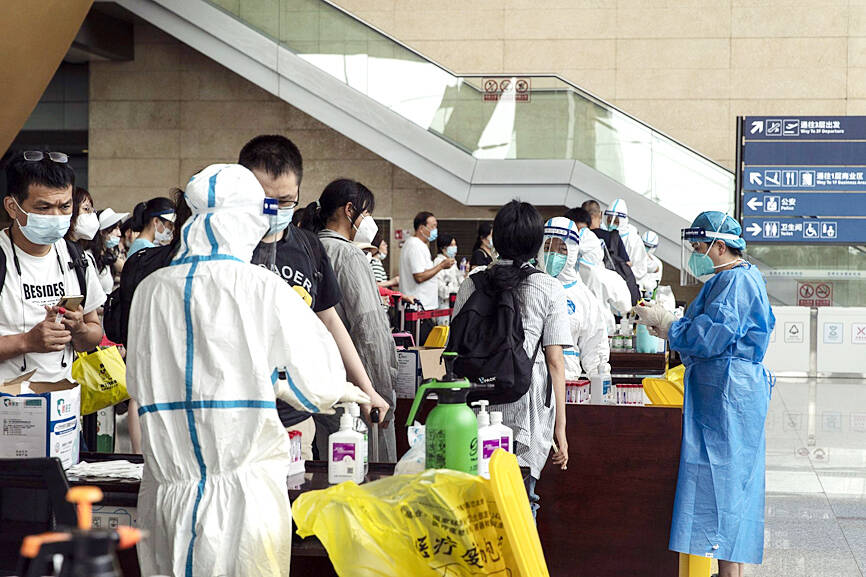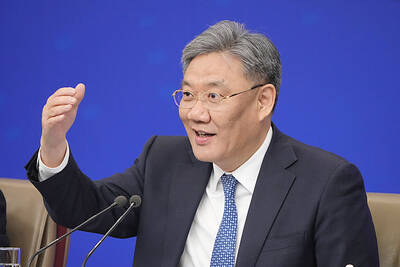China yesterday opened its borders for foreign students for the first time in more than two years, easing restrictions on their entry imposed in the early days of the COVID-19 pandemic.
Foreign nationals holding a Chinese residence permit for study or an APEC business travel card would be allowed to enter the country, the Chinese embassy in the US said in a statement on WeChat on Tuesday.
Similar statements were made by the Chinese embassies in Japan and India.

Photo: Bloomberg
While the country has been allowing some students to enter on an ad-hoc basis for some time, the move shows that Beijing is attempting to normalize aspects of the economy — while holding fast to its “zero COVID-19” approach.
Anyone entering China still faces one of the most intensive pandemic border regimes globally, with mandatory traveler quarantines still in place.
Allowing international students to return does not mean China has relaxed its strict pandemic control measures or that the government has abandoned its dynamic “zero COVID-19” policy, the state-run Global Times reported.
Lu Hongzhou (盧洪洲), a health commentator and president of the Third People’s Hospital in Shenzhen, said further shortening the quarantine period for inbound travelers in the short term is unlikely, the report added.
China still has the world’s toughest entry requirements, even after easing quarantine rules in June. Arriving travelers need to spend seven days in an isolation facility and then monitor their health at home for a further three days. Flights to the country are also limited.
The country welcomed 492,185 foreign students in 2018, low compared with the more than 1 million enrolled in the 2019-2020 academic year in the US, where international education is a significant industry.
Most of China’s students came from South Korea, followed by Thailand and Pakistan.

‘EYE FOR AN EYE’: Two of the men were shot by a male relative of the victims, whose families turned down the opportunity to offer them amnesty, the Supreme Court said Four men were yesterday publicly executed in Afghanistan, the Supreme Court said, the highest number of executions to be carried out in one day since the Taliban’s return to power. The executions in three separate provinces brought to 10 the number of men publicly put to death since 2021, according to an Agence France-Presse tally. Public executions were common during the Taliban’s first rule from 1996 to 2001, with most of them carried out publicly in sports stadiums. Two men were shot around six or seven times by a male relative of the victims in front of spectators in Qala-i-Naw, the center

Incumbent Ecuadoran President Daniel Noboa on Sunday claimed a runaway victory in the nation’s presidential election, after voters endorsed the young leader’s “iron fist” approach to rampant cartel violence. With more than 90 percent of the votes counted, the National Election Council said Noboa had an unassailable 12-point lead over his leftist rival Luisa Gonzalez. Official results showed Noboa with 56 percent of the vote, against Gonzalez’s 44 percent — a far bigger winning margin than expected after a virtual tie in the first round. Speaking to jubilant supporters in his hometown of Olon, the 37-year-old president claimed a “historic victory.” “A huge hug

Canadian Prime Minister Mark Carney is leaning into his banking background as his country fights a trade war with the US, but his financial ties have also made him a target for conspiracy theories. Incorporating tropes familiar to followers of the far-right QAnon movement, conspiratorial social media posts about the Liberal leader have surged ahead of the country’s April 28 election. Posts range from false claims he recited a “satanic chant” at a campaign event to artificial intelligence (AI)-generated images of him in a pool with convicted sex offender Jeffrey Epstein. “He’s the ideal person to be targeted here, for sure, due to

DISPUTE: Beijing seeks global support against Trump’s tariffs, but many governments remain hesitant to align, including India, ASEAN countries and Australia China is reaching out to other nations as the US layers on more tariffs, in what appears to be an attempt by Beijing to form a united front to compel Washington to retreat. Days into the effort, it is meeting only partial success from countries unwilling to ally with the main target of US President Donald Trump’s trade war. Facing the cratering of global markets, Trump on Wednesday backed off his tariffs on most nations for 90 days, saying countries were lining up to negotiate more favorable conditions. China has refused to seek talks, saying the US was insincere and that it